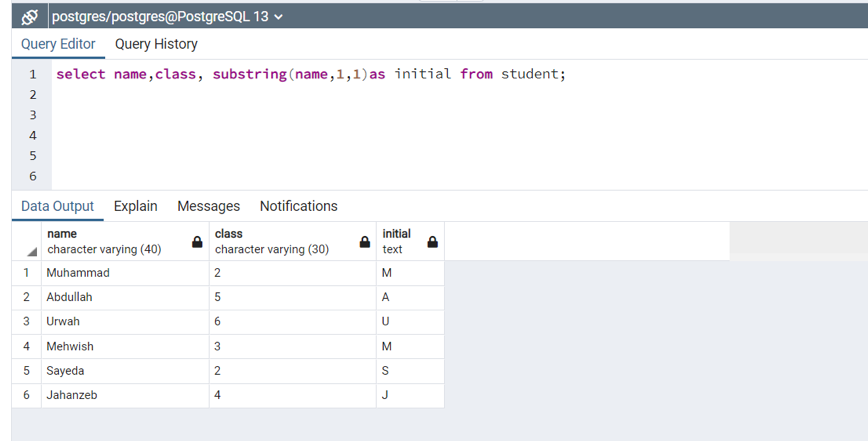

Matching Substrings with SQL Regular Expression We now have a basic idea of the name of every book. Step 3) Type the query in the query editor: SELECT From the navigation bar on the left- Click Databases.The above queries where we don’t need a database can be executed directly from the query editor window. Now let’s see how the actions are performed using pgAdmin. In the pattern, we are searching for a numeric pattern in our string when this is found, the substring function should only extract two characters. The matching_pattern is the pattern to be used for searching in the string. The string is the source string whose data type is varchar, char, string, etc. Here is an explanation of the above parameters: In this case, the substring function is used with the following syntax: SUBSTRING(string FROM matching_pattern) In PostgreSQL, we can extract a substring matching a specified POSIX regular expression. We now have a rough idea about the name of every book. However, we can extract only the first 15 characters from the name column of the table: SELECT We want to get a rough idea about the name of each book. We have started extraction at position 5, and 2 characters have been extracted. Here is another example: SELECT substring('Guru99' from 5 for 2) Since the number of characters to be extracted was not specified, the extraction ran to the end of the string.

Let us extract 99 from the string Guru99: SELECT substring('Guru99' from 5) We specified that the extraction of the substring should begin from position 1, and 4 characters should be extracted. The following example shows how to specify the starting position: SELECT substring('Guru99' from 1 for 4) 4 characters were extracted to return the above. We did not specify the starting position, so the extraction of the substring start at position 1. In this example, we want to extract the first 4 characters from the word Guru99: SELECT substring('Guru99' for 4) If you omit this parameter, the function will extract from starting_position to the end of the string. It denotes the number of characters to be extracted from the string. If you omit this parameter, the extraction will start from position 1, which is the first character in the string. It denotes the place where the extraction of the string will begin. The source string whose data type is varchar, char, string, etc. The PostgreSQL substring function takes the following syntax: substring( string ) Matching Substrings with SQL Regular Expression.In this PostgreSQL tutorial, you will learn: Instead of returning the whole string, it only returns a part of it. You can find more numeric formatting information in the PostgreSQL documentation.The PostgreSQL substring function helps you to extract and return part of a string. Here are the most used symbols for this mask: symbol The last symbol, ‘S’, specifies the use of a plus or minus sign (our number is negative, so it gets a minus). After the decimal symbol comes ‘99’, or two fractional digits. The ‘D’ symbol specifies a decimal marker (here, a point/dot ‘.’). Next, ‘999’ indicates three more digits (800). The ‘9’ indicates one digit (in our example, 5) and ‘G’ represents a group of digits (in our example, one space indicates a group of thousands). In this example, this mask contains the symbol ‘FM’, which removes leading and trailing spaces. The format string describes the string containing the number (input value as string). This function takes two arguments: the string to convert and the format mask that indicates how each character in the string should be interpreted. Use the TO_NUMBER() function if you need to convert more complicated strings. The PostgreSQL database provides one more way to convert. Notice that CAST(), like the :: operator, removes additional spaces at the beginning and end of the string before converting it to a number. You can also use the standard SQL operator, CAST(), instead of the :: operator. This operator is used to convert between different data types. In our example, we converted the string ‘ 5800.79 ’ to 5800.79 (a DECIMAL value). Use the :: operator to convert strings containing numeric values to the DECIMAL data type. Here’s the query you’d write:Īs you notice, the leading and trailing spaces were removed. Let’s convert the value in a string to a DECIMAL datatype. You’d like to convert a string to a decimal value in PostgreSQL.


 0 kommentar(er)
0 kommentar(er)
